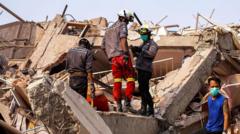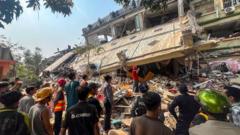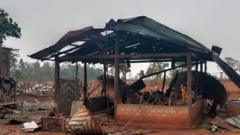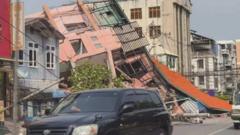This article explores the causes of the earthquake and the unforeseen consequences in Thailand's capital.
### Myanmar Earthquake Triggers Tragic Building Collapse in Bangkok
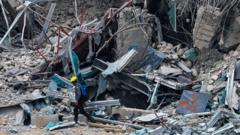
### Myanmar Earthquake Triggers Tragic Building Collapse in Bangkok
A devastating earthquake in Myanmar has resulted in over 1,000 fatalities and significant structural damages, even impacting buildings in distant Bangkok.
The recent earthquake in Myanmar, which struck on Friday, registered a magnitude of 7.7 and has led to staggering losses, with reports indicating over 1,000 lives lost and numerous buildings reduced to rubble. Despite Myanmar's known seismic activity, the earthquake's effects reached far into Thailand, resulting in the collapse of a yet-to-be-finished skyscraper in Bangkok, which is situated more than 1,000 kilometers (621 miles) from the earthquake’s epicenter.
This powerful earthquake was the result of constant movement in the earth’s tectonic plates, with Myanmar sitting atop the convergence of four significant plates: the Eurasian, Indian, Sunda, and Burma microplate. Geologists assert that this area is among the most seismically active globally, particularly because of the Sagaing fault that extends over 1,200 kilometers (746 miles) through Myanmar. Dr. Rebecca Bell, a tectonics expert from Imperial College London, explained that the earthquake occurred due to "strike-slip" motions along the fault line, where friction builds until suddenly released, triggering significant shifts in the earth's crust.
What made this earthquake felt so far away was its shallow depth of just 10 kilometers, which amplified surface shaking. The event produced energy levels exceeding those of the atomic bomb dropped on Hiroshima, according to assessments by the United States Geological Survey. This energy travelled down the fault line towards Thailand, affecting even the soils of Bangkok, which are known for amplifying seismic waves due to their softness.
Amidst reports of buildings swaying dramatically in Bangkok during the quake, the unfinished skyscraper in the Chatuchak district appeared to be the sole casualty among the high-rises. Experts like Dr. Christian Málaga-Chuquitaype noted that prior to 2009, Bangkok lacked strict building codes against earthquakes. However, the collapsed skyscraper fell under updated regulations. As it was still under construction at the time of the quake, its architectural design—a "flat slab" system that favors cost-efficiency over safety—was likely a significant contributing factor to its failure during the seismic shocks.
In Myanmar, the devastation has been exacerbated by longstanding issues like poverty and political unrest, which have hampered the enforcement of building codes and regulations. Many structures in areas such as Mandalay are vulnerable due to inadequate construction practices or location choices prone to flooding and seismic risks.
Seismologists, including Dr. Ian Watkinson of Royal Holloway University, suggest that the low enforcement of building codes in Myanmar has made many buildings ill-prepared for such deadly earthquakes. The occurrence of liquefaction—where saturated soil behaves like a liquid under stress—has further increased risks for structures in floodplain areas, making collapses more likely.
As rescue efforts continue, experts warn of potential aftershocks that may threaten recovery operations and existing structures near fault lines, cautions that resonate strongly given the geological instability of the region.
This powerful earthquake was the result of constant movement in the earth’s tectonic plates, with Myanmar sitting atop the convergence of four significant plates: the Eurasian, Indian, Sunda, and Burma microplate. Geologists assert that this area is among the most seismically active globally, particularly because of the Sagaing fault that extends over 1,200 kilometers (746 miles) through Myanmar. Dr. Rebecca Bell, a tectonics expert from Imperial College London, explained that the earthquake occurred due to "strike-slip" motions along the fault line, where friction builds until suddenly released, triggering significant shifts in the earth's crust.
What made this earthquake felt so far away was its shallow depth of just 10 kilometers, which amplified surface shaking. The event produced energy levels exceeding those of the atomic bomb dropped on Hiroshima, according to assessments by the United States Geological Survey. This energy travelled down the fault line towards Thailand, affecting even the soils of Bangkok, which are known for amplifying seismic waves due to their softness.
Amidst reports of buildings swaying dramatically in Bangkok during the quake, the unfinished skyscraper in the Chatuchak district appeared to be the sole casualty among the high-rises. Experts like Dr. Christian Málaga-Chuquitaype noted that prior to 2009, Bangkok lacked strict building codes against earthquakes. However, the collapsed skyscraper fell under updated regulations. As it was still under construction at the time of the quake, its architectural design—a "flat slab" system that favors cost-efficiency over safety—was likely a significant contributing factor to its failure during the seismic shocks.
In Myanmar, the devastation has been exacerbated by longstanding issues like poverty and political unrest, which have hampered the enforcement of building codes and regulations. Many structures in areas such as Mandalay are vulnerable due to inadequate construction practices or location choices prone to flooding and seismic risks.
Seismologists, including Dr. Ian Watkinson of Royal Holloway University, suggest that the low enforcement of building codes in Myanmar has made many buildings ill-prepared for such deadly earthquakes. The occurrence of liquefaction—where saturated soil behaves like a liquid under stress—has further increased risks for structures in floodplain areas, making collapses more likely.
As rescue efforts continue, experts warn of potential aftershocks that may threaten recovery operations and existing structures near fault lines, cautions that resonate strongly given the geological instability of the region.







